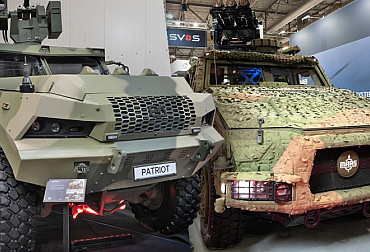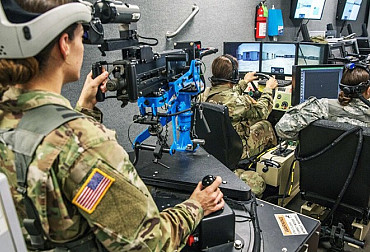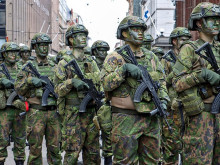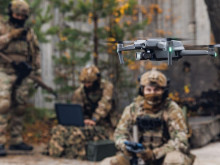Loitering munition for the Army of the Czech Republic. The Israeli system was also chosen by the U.S. Marine Corps
Today's battlefields require precision systems that can track and engage time-sensitive targets and that can be controlled until the final strike, or the strike can be stopped at the last minute and the drone called off. So-called loitering munition play a vital role in this. These are airborne weapons that can remain in the air while searching for a target, and some are capable of returning to base in the event of a failure to identify a target or changed circumstances. They function similarly to armed drones, but differ from them in their self-destruct capability, or the fact that the entire drone acts as a weapon - hence their popular designation as kamikaze drones. Soon they are to come into the armament of the Czech Army. The Ministry of Defence of the Czech Republic is currently negotiating with a specific supplier.
Loitering munitions are a rapidly growing segment within unmanned systems and munitions. Although unmanned munitions have been in use for several decades, their use has increased significantly in recent years and the market is expected to grow at an unprecedented rate in the coming decade. The unmanned munitions market will benefit over the next decade from increased modularity, greater use of artificial intelligence, the use of swarm technology, one of the main objectives of which is to overwhelm enemy air defenses, and greater sensor capabilities. The market will also benefit significantly from the increased proliferation of unmanned systems, as the mass use of these systems reduces the cost of common components, with low cost systems being paramount to their use.
The experience of deploying these systems has been brought about by recent and ongoing conflicts. Among the former, the second Nagorno-Karabakh war in 2020 was a particularly effective deployment of loitering munition by the Azerbaijani armed forces. In this 44-day war, a diverse range of older and modern air and missile strike and defence platforms were deployed. Ballistic missiles of various generations were used, such as the Soviet-made Scud and Tochka missiles, as well as the newer and more advanced Iskander and Israeli-made LORA (Long Range Attack) missiles. Drones of Russian, Turkish, Israeli and indigenous design have performed both reconnaissance missions in support of artillery use and strike missions. Significant successes in the conflict have been achieved by drone attacks and loitering munition (the domestically produced HRESH system, Israeli kamikaze drones Harop, Orbiter 1K, Orbiter-3, SkyStriker and others), capable of effectively destroying heavy ground equipment, including T-72 tanks, S-300 air defense kits, and artillery.
The current war in Ukraine, where loitering munition of various provenance is being deployed by both sides, also provides very significant experience. On the Russian side, these are mainly Iranian Shahid-136 drones and the Russian Lancet system. The Ukrainian armed forces have been successfully using mainly US Phoenix Ghost, Switchblade 300 and 600 drones against the attackers.
The aforementioned supplier, with whom the Czech Ministry of Defence is negotiating, is believed to be the German company Rheinmetall and the Israeli company UVision, which developed the Hero system. This includes five types of suicide drones in the weight categories 3-125 kg with a warhead weighing 0.5-50 kg and a range of 10-200 km. The army is currently planning to procure ten kits of loitering munition for ground forces.

During this year's NATO Days in Ostrava, visitors to the stand of Czechoslovak Group's Retia in Pardubice could learn that the company is involved in industrial cooperation in the integration of the Hero-120, the larger of the two tactical suicide drones of the Hero family. It is a 12 kg suicide drone, of which the warhead is 4.5 kg. It has a range of 40 km and an endurance of 60 minutes. The number of ten kits (ground control station and control console) shows that this is a pilot project from the point of view of the Czech Army, the purpose of which is to introduce the system into the armament and train the operators. In the future, it will be necessary to order orders for an order of magnitude higher numbers of kits, not only of the Hero-120 type, but also possibly larger operational drones Hero-400, 900 or 1250, or on the contrary smaller Hero-30.

The Hero series is designed to provide operating forces on the modern battlefield with maximum operational flexibility. They provide combat forces with unique independent fire capabilities combined with high quality ISR (Intelligence, Surveillance, Reconnaissance) that enable them to organically and independently locate, track and engage time-sensitive, low-signature enemy targets at longer ranges. Drones like Hero can hover over an area of interest, locate and track the enemy, examine potential targets using artificial intelligence, help the operator select the most suitable and valuable ones, also choose the right timing, direction and angle of attack, and then execute a precision strike.
Hero drones feature low noise and low heat, visual and radar signatures. Such features bring an advantage on all kinds of battlefields, including urban ones. They are effective against a variety of targets such as enemy live forces, moving light vehicles, tanks, fortified enemy positions, air defense systems, and key high-value installations such as radars or command posts.

All types of drones in the Hero family have bow-mounted TV and infrared video cameras that allow the operator to monitor what the munitions see throughout the flight. It is this camera feature that sets the drone munitions apart from more traditional missiles. It allows them to operate as small surveillance and reconnaissance drones and then directly hit any target they find. UVision's designs can also be recovered and refurbished for reuse if they complete a mission without making a strike. Thus, in addition to their primary function as loitering munition, the drones can also perform ISR (Intelligence, Surveillance and Reconnaissance) missions where additional batteries can be added in place of the warhead, significantly increasing the endurance of the system.
Drones of this type are currently in the possession of a number of NATO armed forces and are being acquired by others. They are suitable for a wide range of troops and forces and for tactical and strategic missions at short, medium and long ranges, and the different types of this loitering munitions are tailored to this. Depending on the type, the drones of this system are portable and can be mounted on ground vehicles, ships or airborne platforms such as helicopters, which may be an interesting feature in the future in terms of developing the capabilities of the H-1 system combat and multirole helicopters, which are now entering the arsenal of the Air Force.

Rheinmetall announced a significant order for Hero Loitering Munitions in July, with contracts signed from Hungary. The value of the munitions ordered by Hungary is in the low three-digit million euro range. Deliveries are scheduled to begin in 2024 and are scheduled to be completed in 2025. The Hero series drones are also used, for example, by the U.S. Marine Corps (USMC) and special forces of the US armed forces. The launch containers are equipped with LAV-25 armoured vehicles and some vessels.





















